Sambar with steamed rice is one of the most comforting meals, not just for the people in South India but others too. The whole deal of a hot tangy, spiced stew with lentils and veggies brings instant energy in the human body and gratification to the soul! And this Arachuvitta Sambar recipe is nothing different. It is full of nutrition and vegan too. Read on to learn more about the lovely Arachuvitta Sambar and its recipe.
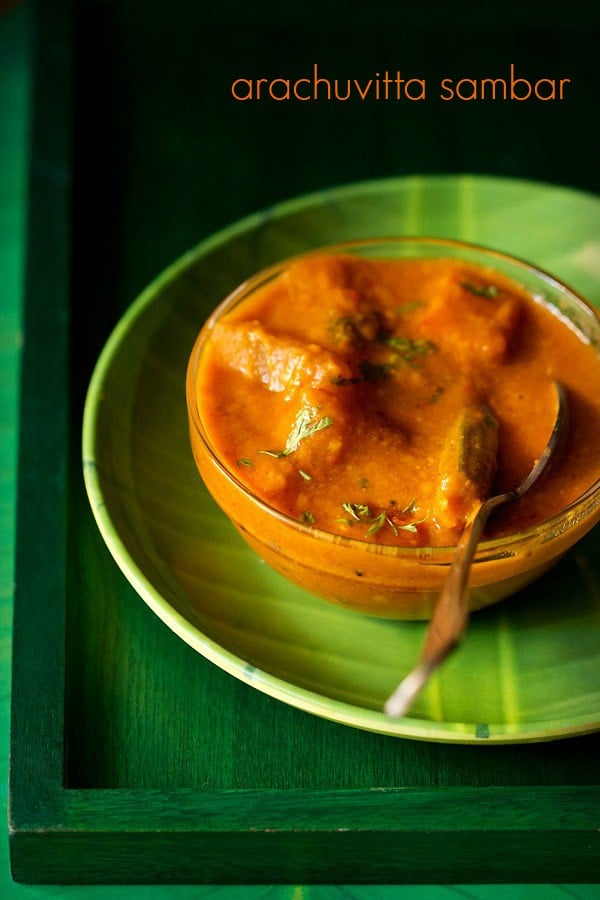
About Arachuvitta Sambar
‘Arachuvitta’ literally translates to ‘ground’ in Tamil. Since the spices are first roasted and then freshly ground with coconut for the masala in this sambar. Hence, the name Arachuvitta Sambar.
Arachuvitta Sambar is an extremely popular, almost a specialty dish in Tambram (Tamil Brahmin) homes.
I can totally vouch for this because I have experienced the flavor and aroma of the freshly ground spice blend in this sambar. It is simply mind-blowing.
It may seem that there are many steps in the making of the Arachuvitta Sambar recipe. But it is simple and easy to make.
You just need to prepare the masala carefully (as it is the ‘star’ in this sambar) and you are good to go.
Yes, I’ll agree to the fact that the Arachuvitta Sambar is one of my favorite South Indian dishes. This version does not have onion, garlic, sambar powder and is also a 100% vegan.
There’s absolutely nothing in this Arachuvitta Sambar recipe that you too would dislike. That’s my guarantee!
Other than the robust freshly ground masala, the choice of vegetables that go into this Arachuvitta Sambar is interesting.
This recipe has drumsticks, ash gourd and carrots in it. But you can add your favorites too. The more, the merrier.
Personally, I am a fan of veggies and greens. Whenever I’m cooking at home, I love to use vegetables like okra (ladyfinger/bhindi), carrot, radish, capsicum, French beans, white or yellow pumpkin and drumsticks in the Arachuvitta Sambar recipe.
Pearl onions, sambar onions and tomatoes give it a good taste too. You can add these as well. The color of this Arachuvitta Sambar depends on the type of red chilies you add. I have used Byadagi (bedgi) red chilies which impart an orange hue to the sambar.
Turn this Arachuvitta Sambar into a complete meal full of goodness, by pairing it with steamed rice. Even I feel this is the best way to enjoy it. You can also savor this with Rava Idli, Set Dosa, vadas or uttapams.
How to make Arachuvitta Sambar
Preparation
1. First rinse ½ cup arhar dal/tur dal (pigeon pea lentils) and add them in a 2 litre pressure cooker.
Next add ¼ teaspoon turmeric powder and 2 cups water. Stir well and pressure cook the lentils for 8 to 9 whistles on medium to medium-high heat.
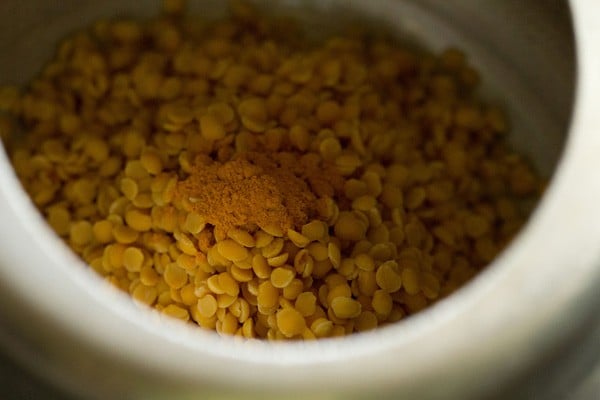
2. While the lentils are getting pressure cooked, take ½ cup hot water and 1.5 tablespoons tightly packed tamarind in a small bowl. Soak the tamarind in hot water for about 20 to 30 minutes.
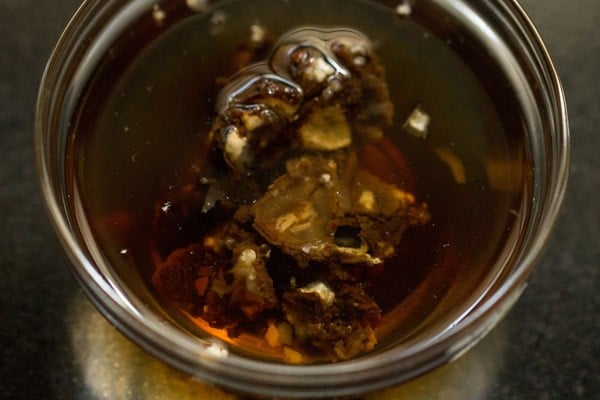
3. Next, heat 2 teaspoons sesame oil (not the Asian variety of sesame oil) in a small pan. Keep the heat to a low.
Add the following spices:
- 4 to 5 dried red chilies (broken and seeds removed)
- 1 tablespoon coriander seeds
- ¼ teaspoon fenugreek seeds
- 1 teaspoon chana dal (husked and split Bengal gram)
- ½ teaspoon black peppercorns
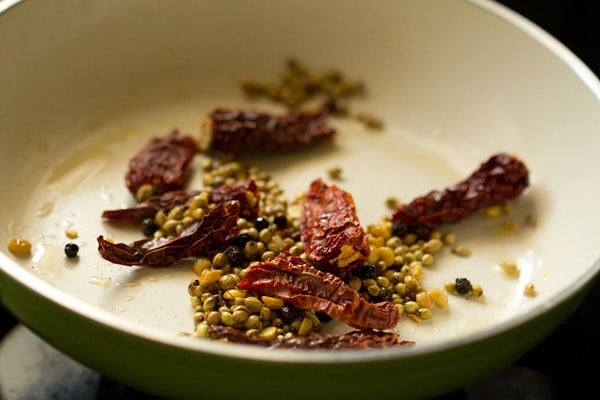
4. Stir and roast the spices on low heat.
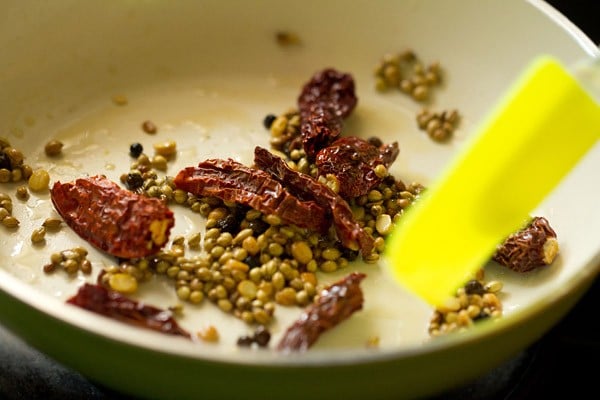
5. Switch off the heat when the spices turn fragrant. Remove the pan from the burner and allow the spices to cool down.
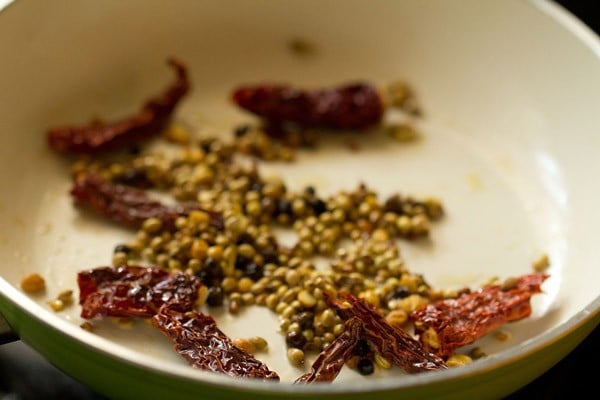
Cook Vegetables
6. Next, heat 2 tablespoons sesame oil (gingelly oil) in a pot or pan. Add 1 teaspoon mustard seeds and let them crackle.
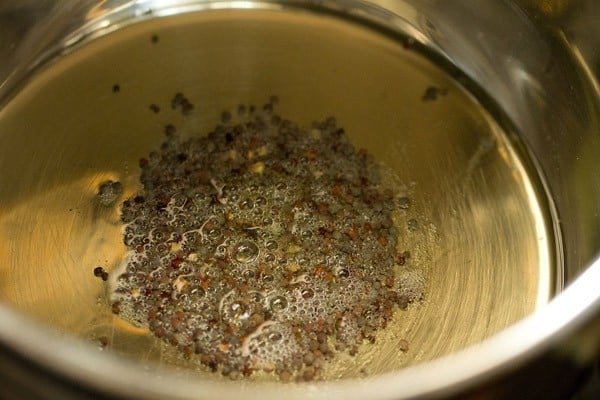
7. Once the mustard seeds crackle, add 2 dried red chilies (broken and seeds removed) and a pinch of asafoetida (hing). Stir and fry till the red chilies change color. Don’t burn them.
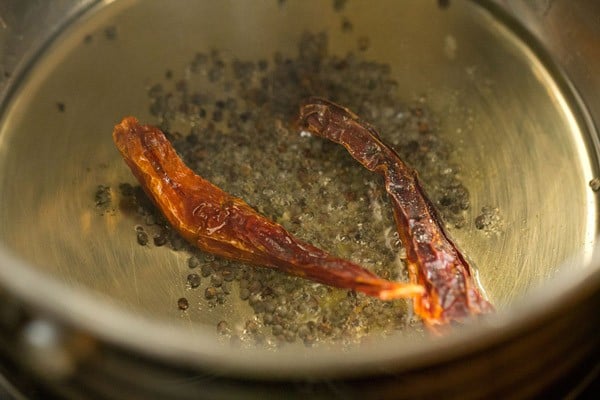
8. Now, add 1 sprig curry leaves (about 12 to 15 curry leaves) and 2 drumsticks (peeled and chopped), 1 cup of diced ash gourd and 1 medium to large carrot (diced).
Note that if you plan to add pearl onions or regular onions, sauté them with curry leaves till they turn translucent.
Add the mixed vegetables after you sauté the onions. You can add about 1.5 cups of mixed vegetables except for drumsticks.
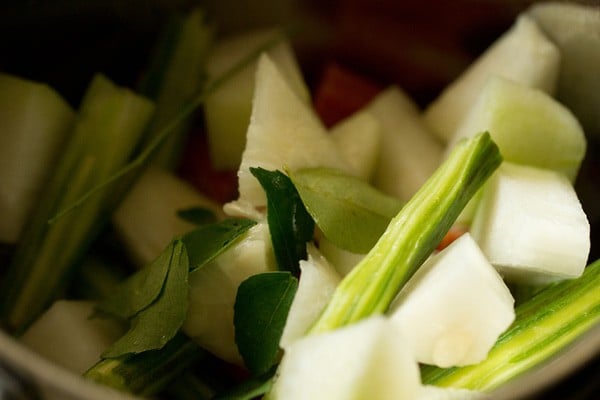
9. Mix very well.
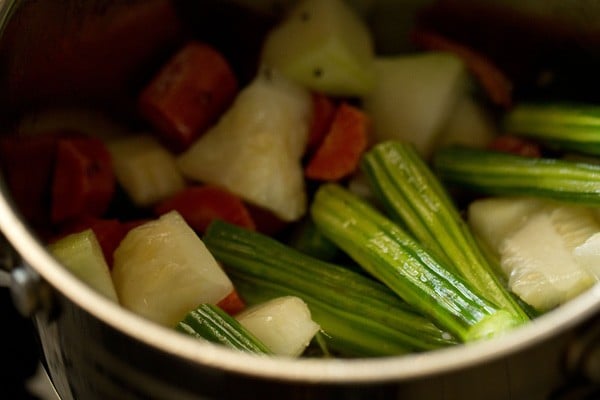
10. By now the tamarind must have got soaked well. Squeeze the pulp from the tamarind in the bowl.
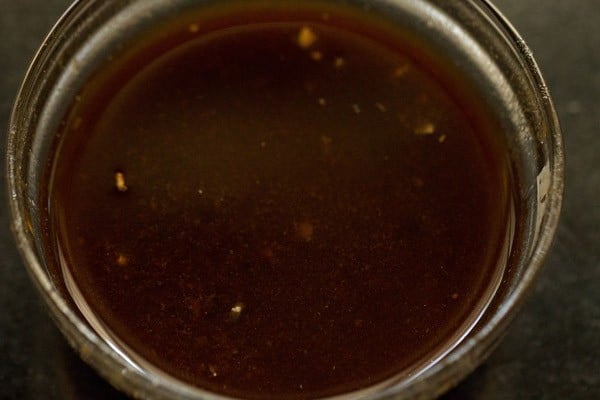
11. Add the tamarind pulp and ¼ teaspoon turmeric powder to the vegetables and stir. If you don’t want a sour taste in the vegetables, add the tamarind pulp later.
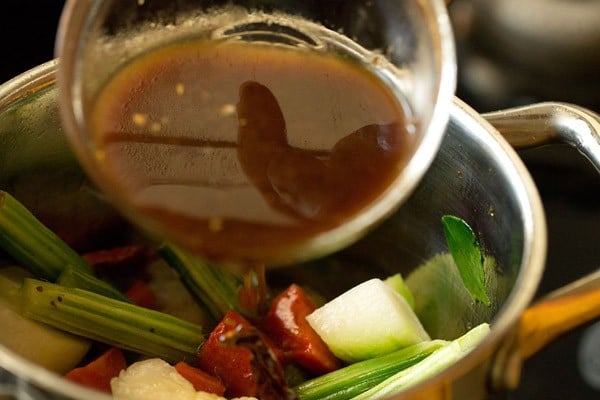
12. Next, add 1 cup water.
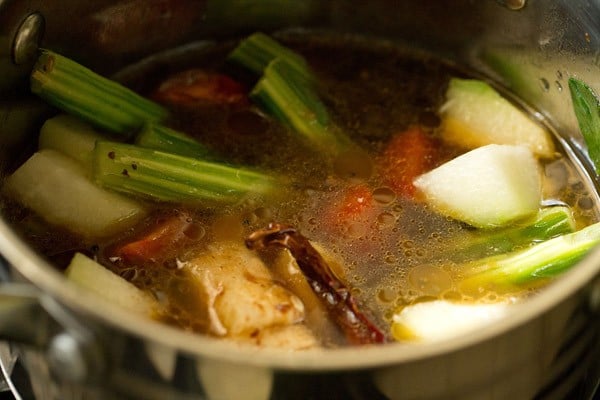
13. Add 1 teaspoon salt or as required.
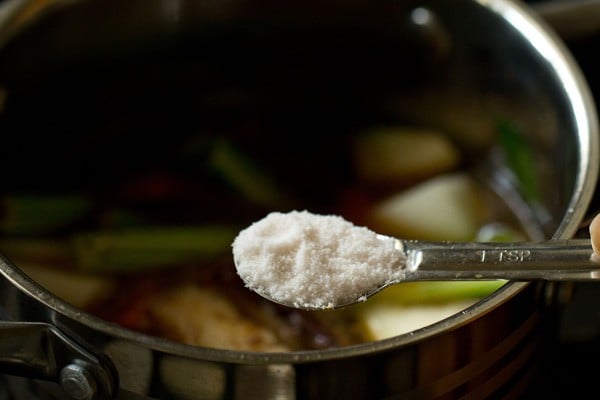
14. Cover the pan and simmer on medium to high heat till the vegetables are cooked and tender.
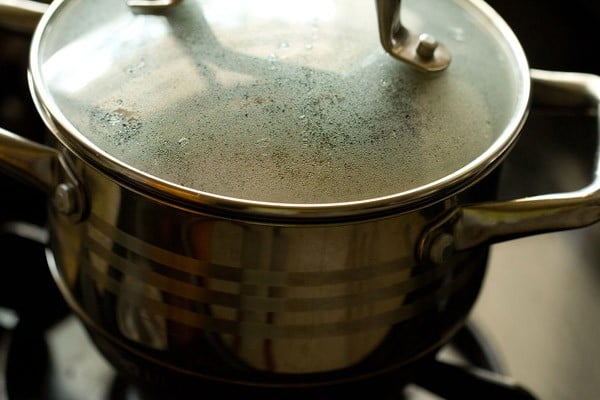
Make Arachuvitta Sambar
15. While the vegetables are cooking, take the roasted spices in a chutney grinder or a wet grinder jar. Add 4 tablespoons fresh grated coconut. If you do not have grated coconut, add desiccated coconut.
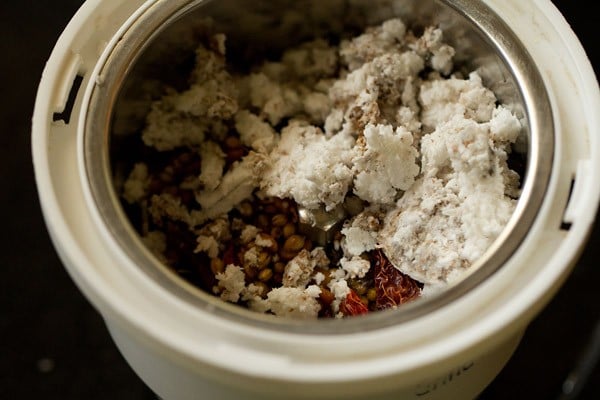
16. Grind to a smooth paste with 5 to 6 tablespoons water. Add more water if required while grinding. Keep this ground sambar masala aside.
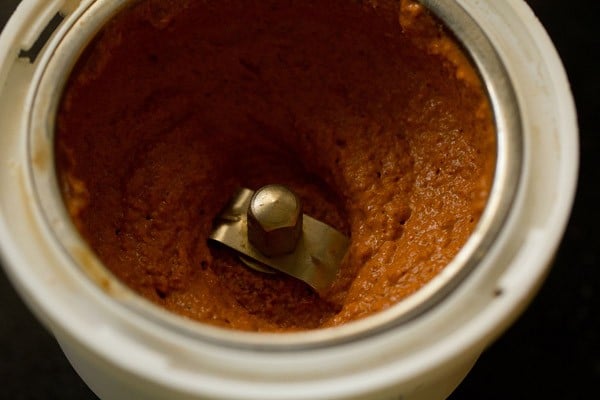
17. When the pressure settles down naturally, open the lid of the cooker and mash the dal with a whisk or spoon.
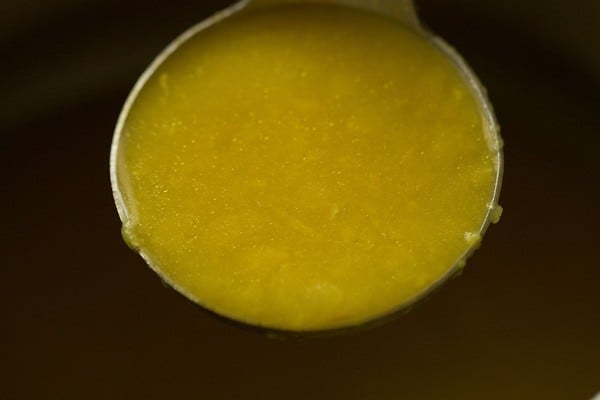
18. The vegetables will be cooked in 20 to 25 minutes. If the water is less while cooking, add some more water.
I added ½ cup water while the vegetables were getting cooked.
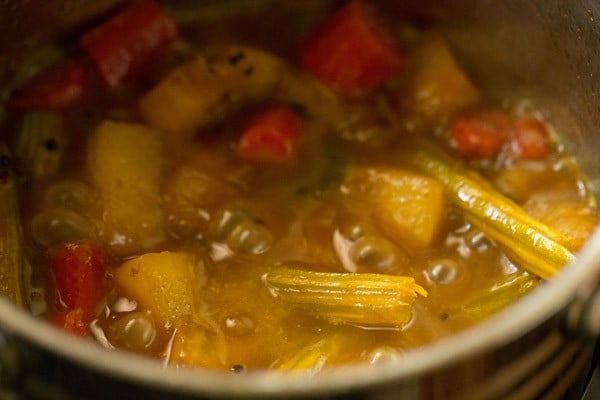
19. Next, add the mashed dal and the freshly ground sambar masala.
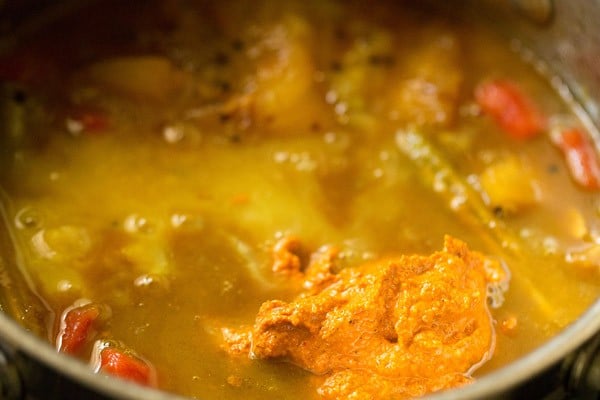
20. Stir very well. If the sambar is thick, add some more water. If it is thin, add 1 to 2 tablespoons rice flour to thicken it. Check the taste and add more salt if required.
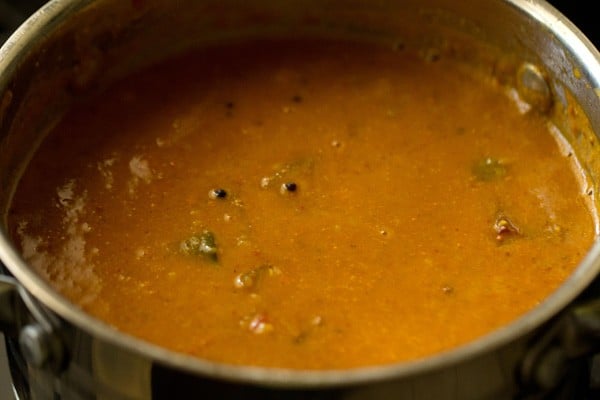
22. Simmer for 4 to 5 minutes more on medium to high heat.
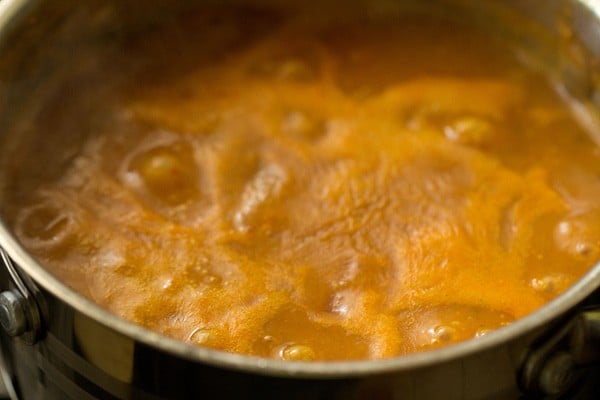
23. Serve the Arachuvitta Sambar hot with steamed rice, idli, set dosa or any South Indian snack. If you want, you can garnish it with some chopped coriander leaves.
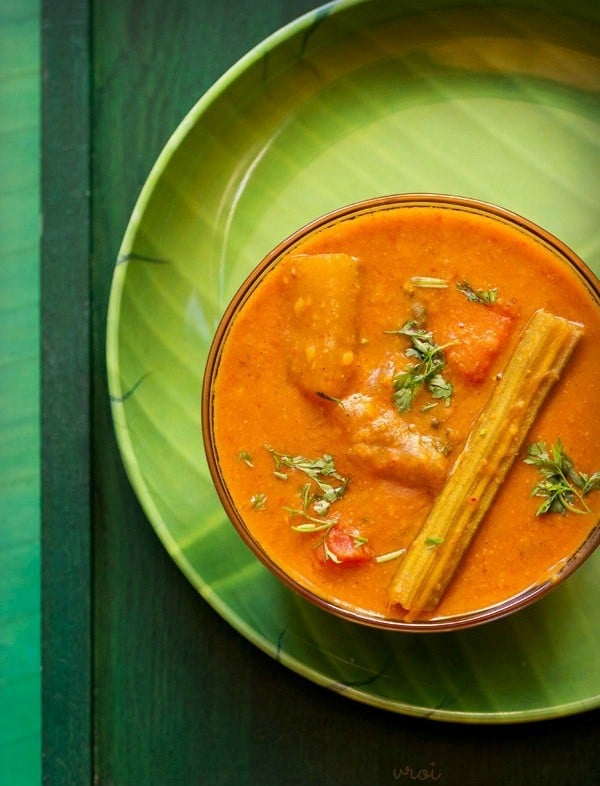
Expert Tips
- Feel free to add vegetables of your choice. You can add about 1.75 to 2 cups diced vegetables that you prefer. Make sure not to over cook the vegetables.
- You can also make this dish with an equal mix of tur dal and moong dal (yellow moong lentils).
- If you don’t wish to have a sour taste in the vegetables, add the tamarind pulp later.
- While grinding the roasted spices for the sambar masala, if you don’t have fresh grated coconut, you can also use desiccated coconut.
- If you feel the water is less while cooking the vegetables for Arachuvitta Sambar, you can add more water. To adjust the consistency of the sambar, you can add more water if it is thick. In case its thin, you can add about 1 to 2 tablespoons rice flour to thicken it.
FAQs
The main difference is that spices are first roasted, then freshly ground with coconut and added to the Arachuvitta Sambar whereas the regular sambar is a tangy stew made with lentils, vegetables and tamarind.
Yes, you can. Add about 1 to 2 teaspoons depending on the sourness and thickness of the tamarind paste.
In Tamil language, ‘arachuvitta’ means freshly ground. Since a freshly ground sambar masala is added in this recipe, it is known as Arachuvitta Sambar.
If the sambar is too thin, add about 1 to 2 tablespoons rice flour to thicken it.
More Sambar Varieties To Try!
South Indian Food Recipes
Tamil Nadu Food
Tamil Nadu Food
Kerala Recipes
Please be sure to rate the recipe in the recipe card or leave a comment below if you have made it. For more vegetarian inspirations, Sign Up for my emails or follow me on Instagram, Youtube, Facebook, Pinterest or Twitter.
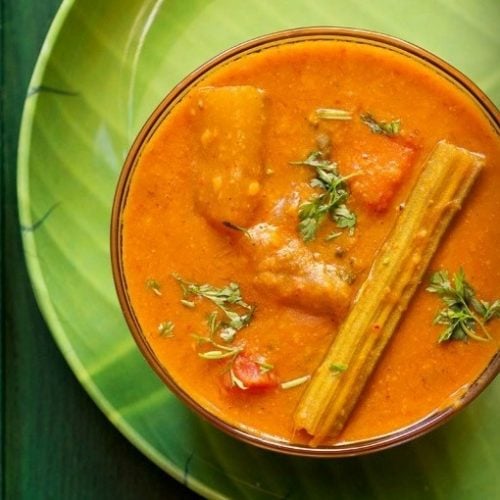
Arachuvitta Sambar Recipe
Ingredients
For Pressure Cooking Lentils
- ½ cup pigeon pea lentils (tur dal or arhar dal) – 110 grams
- 2 cups water – for pressure cooking
- ¼ teaspoon turmeric powder (ground turmeric)
- ½ teaspoon oil – optional
Cooking Veggies
- 2 drumsticks
- 250 grams ash gourd (white pumpkin) or about 1 cup of diced ash gourd
- 1 carrot – medium to large
- 3 to 4 shallots or 1 medium size onion – optional
- 2 tablespoons sesame oil (gingelly oil)
- 1 teaspoon mustard seeds
- 2 dried red chilies
- 1 sprig curry leaves or 12 to 15 curry leaves
- 1 pinch of asafoetida (hing)
- 1 to 1.5 cups water
- ¼ teaspoon turmeric powder (ground turmeric)
- 1 teaspoon salt
For Spices & Coconut Paste
- 4 to 5 dried red chillies
- 1 tablespoon coriander seeds
- ¼ teaspoon fenugreek seeds
- 1 teaspoon chana dal (husked and split Bengal gram)
- ½ teaspoon black peppercorns
- 2 teaspoons sesame oil (gingelly oil)
- 4 tablespoons fresh grated coconut
- 5 to 6 tablespoons water – for grinding
For Tamarind Pulp
- 1.5 tablespoons tightly packed tamarind – seedless
- ½ cup hot water
Instructions
Pressure cooking lentils
- First, rinse tuvar dal a few times and add them to a 2 to 3 litre pressure cooker. Also add turmeric powder and 2 cups water. Stir well and pressure cook the lentils for 8 to 9 whistles on medium to medium high heat.
- When the pressure settles down naturally, open the lid of the cooker and mash the dal with a wired whisk or spoon.
Preparing tamarind pulp
- While the dal is getting pressure cooked, take ½ cup of hot water and tightly packed tamarind in a small bowl. Soak the tamarind in the hot water for about 20 to 30 minutes.
- Later, squeeze the pulp from the tamarind in the bowl. Keep aside.
Making Spices & Coconut Paste
- Next, heat sesame oil (not the Asian variety of sesame oil) in a small pan. Keep the heat to a low. Add dried red chilies, coriander seeds, fenugreek seeds, chana dal and whole black pepper.
- Stir and roast the spices on low heat.
- When the spices become fragrant, switch off the heat and keep the pan down. Allow the roasted spices to cool down.
- Take the roasted spices in a chutney grinder or a wet grinder jar. Add fresh grated coconut.
- Grind to a smooth paste with 5 to 6 tablespoons water. Add more water if required while grinding. Keep this ground sambar masala aside.
Making Arachuvitta Sambar
- Next, heat sesame oil in a pot or pan. Then, add mustard seeds and let them crackle.
- Once the mustard seeds crackle, add dried red chilies and asafoetida. Stir and sauté till the red chilies change color. Don't burn them.
- Now, add curry leaves and drumsticks (chopped), diced ash gourd and diced carrot. If you want to add pearl onions or regular onions or shallots, then sauté them with curry leaves till they turn translucent. Add the mixed vegetables after you sauté the onions. Stir and mix very well.
- Add the tamarind pulp and turmeric powder to the vegetables. Stir well. If you don't want a sour taste in the vegetables, add the tamarind pulp later.
- Next, add 1 cup water and salt. While the vegetables are cooking, if the water is less, do add more water.
- Cover the pan and simmer on medium to high heat till the vegetables are cooked.
- In 20 to 25 minutes, the vegetables will be cooked.
- Then, add the mashed dal and the freshly ground sambar masala.
- Stir very well. If the Arachuvitta Sambar looks very thick, then add some more water. If thin, then add 1 to 2 tablespoons rice flour to thicken it.
- Simmer for 4 to 5 minutes more on medium to high heat.
- Serve the Arachuvitta Sambar hot with steamed rice, idli, dosa or any South Indian snack. If you prefer, you can also garnish it with some chopped coriander leaves.
Notes
- You can also add about 1.75 to 2 cups diced vegetables of your choice.
- Instead of making the tamarind pulp add about 1 to 2 teaspoons of packaged tamarind paste – adjust according to the tanginess you prefer.
- You can use any neutral flavored oil instead of sesame oil. The sesame oil that is used in this recipe is the oil extracted from raw sesame seeds and not toasted sesame seeds. Kindly do not use toasted sesame oil.
Nutrition Info (Approximate Values)
Arachuvitta Sambar recipe from the blog archives was first published on May 2015.
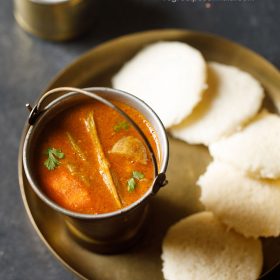
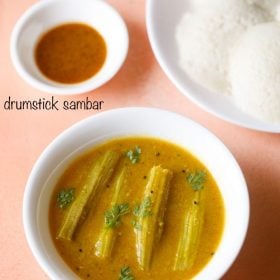
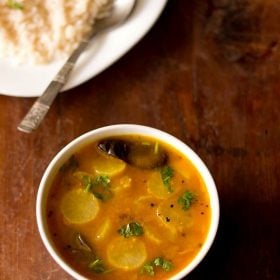
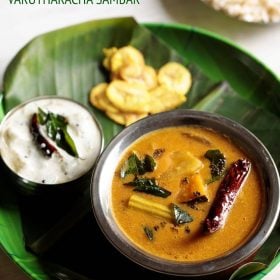
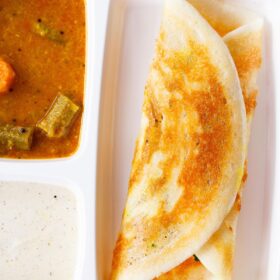
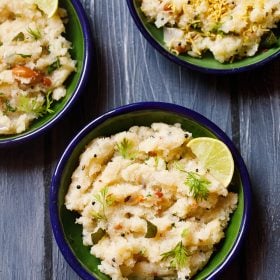
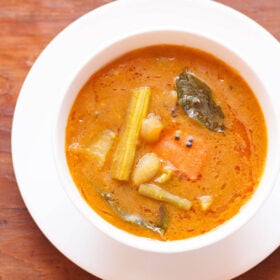
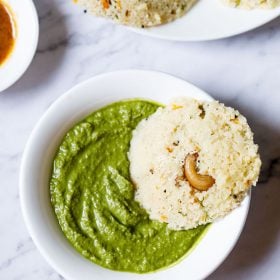








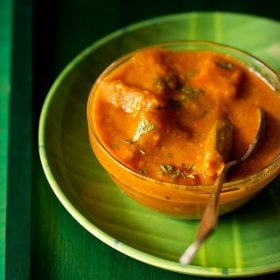
I will try this with leftover cooked lentils. I like your this idea you have mention methods 2 times. Then you have added tick box for ingredients.
You added picture and videos with method by method in details, and also you added the cooking mode so that phone doesn’t sleep while cooking.
Hallo from Milan, Italy! I have already cooked this recipe twice and it never failed. Thank you for the recipe!
Great and thanks for sharing this nice feedback.
Beautiful recipe, thank u..
Just tried it out and it has come out beautiful..
Thanks once again
welcome always roshni and thankyou for your positive words.
I have one question ……how to make sambhar for 8 people?
this recipe serves 4. just increase the ingredients proportionately.
I had read a very similar version of this recipe called Kootu(think its a dish from Karnataka or Andhra) long back. But very nice presentation and explanation. And it sure looks mouth watering
thanks.
Arachu means ground (past tense of “to grind”)
Vitta means poured.
Adding rice flour to thicken is not a good idea. Better to warn people to be careful while adding water. Also while adding lentils (toor daal) one needs to be careful not to over power the, main taste of the “arachu vitta” spices. Also the final taste come after the first boil of the entire sambhar after adding the toor daal.
Thanks for the info and inputs. A recipe varies from family to family and this is how I make this dish. Rice flour does help in thickening if the gravy becomes thin. Many a times people do not have measuring cups and so the water added can be less or more. So I do mention what to do if this happens if the gravy becomes thick or thin.
nausheen, i will try to add the recipe soon.
If I want to use mixer to grate fresh coconut , should I remove black n brown skin of coconut or use as it is
neha, use can use the brown skin on coconut flesh.
U mean with skin I should grind it
neha, the skin but not the outer shell. when i scrape coconut i also scrape the brown part. you can use dessicated coconut also.
Nice recepie I have made its so good
thanks kajal
its very useful site.cooking is my passion.want to know about recipes of all states.this is going to be a great help.
thanks poonam
Ummm sounds delicious. One question am a south Indian and hav never seen any sambar without hing. Was it left out purposely.
thanks swetha. hing is added in the recipe. its there in the recipe post.
Ur sambar recepies is very easy nd testy and ur method step by step is simple.so very thanks
welcome vijay. good to know this.
Hello! This recipe looks really delicious.
I’m Italian and don’t know the spices you name, but I guess if I go to some asian shop they must know…
Most grateful,
Sabrina.
thanks sabrina. yes you should be able to get these spices in the shop selling asian or indian stuff.
Nice and yummy recipe with drumsticks, dal and pumpkin.. Looks absolutely delicious
Looks Yummy and mouthwatering love south indian recipe specially sambhar..
thanks hercules
I tried this recipe and really loved it
thanks for the feedback deepti.
Thnx for the recipe,if I want to use tamarind paste then what will be the quantity
welcome neha. add from 1 to 2 tsp depending upon the thickness and sourness in the tamarind paste.